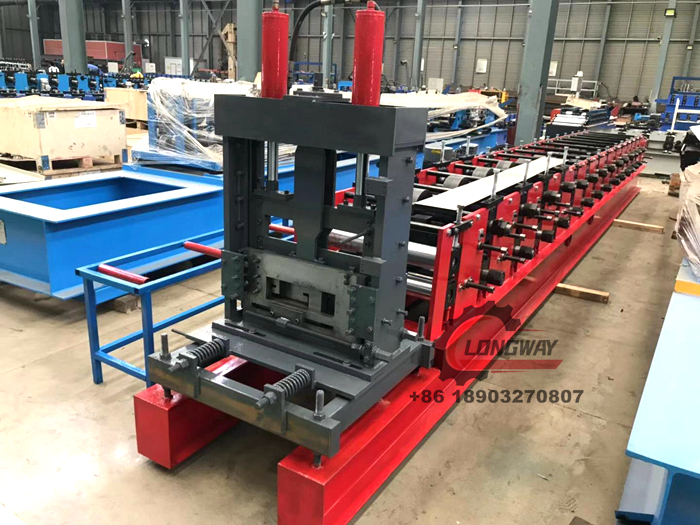roll forming bending machine
The Role and Significance of Roll Forming Bending Machines in Modern Manufacturing
In the ever-evolving landscape of manufacturing, efficiency and precision are paramount. Among the various techniques employed to shape metal products, roll forming and bending stand out due to their ability to produce consistent and high-quality results. Roll forming bending machines have emerged as vital tools in this domain, enabling manufacturers to create complex shapes and profiles with ease.
Roll forming is a process that involves feeding a long strip of metal through a series of rollers, each designed to progressively bend the material into a specific shape. This method is particularly favored for producing continuous lengths of metal sections, such as channels, angles, and other custom profiles. When combined with bending operations, these machines can further enhance the versatility of metal fabrication, allowing manufacturers to achieve intricate designs that might be challenging or impossible to produce using traditional machining methods.
The Mechanics of Roll Forming Bending Machines
A roll forming bending machine typically consists of several key components the material feed system, rolling stations, bending units, and control systems. The process begins with the loading of a metal roll into the machine, which then feeds the material through the rollers. Each roller in the station is strategically configured to incrementally bend the metal into the desired profile. This continues until the material reaches the final shape, which can be custom-tailored to meet specific requirements.
Bending operations can be integrated into the roll forming line, allowing for the simultaneous creation of both bent and rolled shapes. This approach maximizes efficiency by reducing the number of processing steps and minimizing material waste. The precision of modern CNC (Computer Numerical Control) technology further enhances the capabilities of these machines, enabling accurate replication of complex geometries with minimal human intervention.
Applications Across Industries
The applications of roll forming bending machines are vast and varied, spanning numerous industries. In the construction sector, they are used to manufacture components such as roofing panels, wall studs, and structural supports. Their ability to produce lightweight yet strong profiles makes them ideal for modern building projects that prioritize efficiency and sustainability.
roll forming bending machine

In the automotive industry, roll forming bending machines play a crucial role in producing chassis components, frame sections, and various other parts that require high strength-to-weight ratios
. The need for precision and durability in automotive fabrication aligns perfectly with the capabilities of these machines, leading to improved safety and performance standards.Electronics manufacturers also benefit from the precision shaping made possible by roll forming bending machines. They are utilized to create enclosures, brackets, and other structural parts that require intricate designs and reliable structural integrity. As technology advances, the demand for custom shapes and parts is increasing, further solidifying the importance of roll forming techniques in modern manufacturing.
Advantages of Roll Forming Bending Machines
One of the primary advantages of using roll forming bending machines is the significant reduction in material waste. The continuous process minimizes scrap rates compared to traditional machining methods. Additionally, these machines offer high production speeds, making them suitable for high-volume manufacturing environments.
Moreover, the versatility of roll forming bending machines allows various materials, including steel, aluminum, and zinc-coated metals, to be processed. This adaptability ensures that manufacturers can meet diverse customer needs and respond swiftly to market changes.
Another benefit is the improved consistency in product quality. With precise control over the rolling and bending processes, manufacturers can produce components with uniform dimensions and tolerances, reducing the need for extensive quality control measures post-production.
Conclusion
In conclusion, roll forming bending machines are indispensable in the modern manufacturing landscape. Their ability to efficiently produce complex profiles with high precision positions them as essential tools across various industries, including construction, automotive, and electronics. As technology continues to advance, the role of these machines in enhancing productivity and quality will only grow, paving the way for innovative solutions in metal fabrication. Embracing the capabilities of roll forming bending machines represents a forward-thinking approach that aligns with the demands of today's fast-paced manufacturing environment.
-
Roof Panel Machines: Buying Guide, Types, and PricingNewsJul.04, 2025
-
Purlin Machines: Types, Features, and Pricing GuideNewsJul.04, 2025
-
Metal Embossing Machines: Types, Applications, and Buying GuideNewsJul.04, 2025
-
Gutter Machines: Features, Types, and Cost BreakdownNewsJul.04, 2025
-
Cut to Length Line: Overview, Equipment, and Buying GuideNewsJul.04, 2025
-
Auto Stacker: Features, Applications, and Cost BreakdownNewsJul.04, 2025
-
Top Drywall Profile Machine Models for SaleNewsJun.05, 2025








